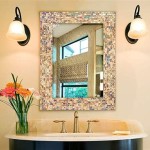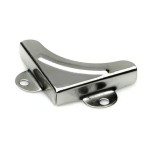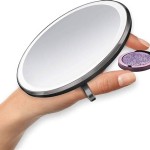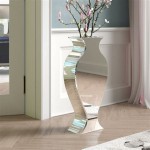How To Hang A Mirror On A Door Without Damaging It
Hanging a mirror on a door can be a practical solution for maximizing space, particularly in smaller rooms like bedrooms, bathrooms, or closets. It provides a full-length reflection without requiring wall space and can even visually expand the room. However, the prospect of damaging the door – scratching the paint, creating unwanted holes, or compromising its structural integrity – often deters individuals from pursuing this seemingly simple project. Fortunately, several methods exist that allow for secure mirror installation without inflicting permanent damage on the door. The key lies in utilizing appropriate materials and techniques that prioritize preservation of the door's surface and structure.
Before commencing the installation process, careful consideration should be given to the type of door, the weight and size of the mirror, and the desired placement. Hollow-core doors, for example, are less robust than solid-core doors and require lighter mirrors and gentler hanging methods. Overlooking these factors can lead to unsatisfactory results, including the mirror falling or causing damage to the door in the long run. A thorough assessment of these elements will guide the selection of the most suitable and damage-free method for hanging the mirror.
Assessing the Door and Mirror
The first crucial step is to thoroughly evaluate the door's composition and construction. Hollow-core doors, characterized by their lightweight construction and honeycomb-like interior, are significantly less capable of supporting heavy loads compared to solid-core doors. Attempting to hang a heavy mirror on a hollow-core door without proper reinforcement can cause the door to warp, crack, or even collapse. To determine if a door is hollow-core, gently knock on its surface. A hollow sound indicates a hollow-core construction, while a more solid thud suggests a solid-core door.
The weight of the mirror is another critical factor. Heavier mirrors require more robust hanging solutions to prevent them from falling and causing damage or injury. It's advisable to weigh the mirror accurately using a bathroom scale or similar device. This measurement will help determine the appropriate type of adhesive, hooks, or brackets to use for secure and safe installation. Furthermore, consider the mirror's size and how it will affect the door's balance and functionality. A large, heavy mirror placed off-center can strain the door hinges and make it difficult to open and close smoothly.
Lastly, examine the door's surface. Is it painted, stained, or lacquered? The type of finish will influence the selection of adhesive materials. Some adhesives may damage or discolor certain finishes, necessitating the use of protective barriers or alternative hanging methods. Cleaning the door's surface with a mild detergent and water will remove any dirt, grease, or dust that could interfere with the adhesion process. Ensure the surface is completely dry before proceeding with any installation steps.
Choosing the Right Hanging Method
Several damage-free hanging methods are available, each with its own advantages and limitations. The selection should be based on the door type, mirror weight, and desired aesthetic.
Over-the-Door Hooks: These hooks are a convenient and generally safe option for hanging lighter mirrors. They simply hook over the top edge of the door, distributing the weight evenly. However, it's essential to choose hooks specifically designed for doors, as standard hooks may be too thick and prevent the door from closing properly. Opt for hooks with padding or felt on the inside to protect the door's surface from scratches. These hooks are most suitable for hollow-core doors and lighter mirrors, typically those weighing less than 5-10 pounds.
Adhesive Strips: Command Strips and similar adhesive products are designed to hold a significant amount of weight without damaging surfaces. These strips utilize a strong adhesive that bonds to both the door and the mirror. However, careful selection is crucial. Make sure to choose strips that are rated for the weight of the mirror, and follow the manufacturer's instructions precisely. Improper application can result in the mirror falling and potentially causing damage. It's also advisable to test the adhesive's strength in an inconspicuous area of the door before applying it to the entire mirror. Thoroughly cleaning both surfaces with rubbing alcohol ensures optimal adhesion.
Adhesive Mirror Mounting Tape: Similar to adhesive strips, mirror mounting tape is specifically designed for securing mirrors to surfaces. This tape typically features a double-sided adhesive with a strong bond. However, it's important to note that while some brands claim to be damage-free, they may still leave residue upon removal. Always test the tape in an inconspicuous area before applying it to the entire mirror. Choose a high-quality tape rated for the weight of the mirror, and apply it evenly across the entire back surface of the mirror for maximum adhesion. Ensure the door's surface is clean, dry, and free of any loose paint or debris.
Door Mirror Hangers: These hangers are designed specifically for holding mirrors on doors. They work by clamping onto the top and bottom edges of the door, effectively sandwiching the mirror between them. These hangers usually don't require any adhesive or drilling. The weight is distributed evenly across the door's surface, minimizing the risk of damage. Choose hangers that are adjustable to accommodate different door thicknesses and mirror sizes. Ensure the hangers have soft padding on the contact points to protect the door's finish. This option is suitable for both hollow-core and solid-core doors, depending on the weight capacity of the hangers.
Installation Techniques for Damage Prevention
Regardless of the chosen hanging method, certain techniques can minimize the risk of damage to the door.
Proper Surface Preparation: Cleaning the door's surface is paramount for optimal adhesion when using adhesive strips or tape. Use a mild detergent and water to remove any dirt, grease, or dust. Rinse thoroughly and allow the surface to dry completely before applying any adhesive. For enhanced adhesion, wipe the area with rubbing alcohol before application. Avoid using harsh chemicals or abrasive cleaners, as these can damage the door's finish.
Even Weight Distribution: Distributing the weight of the mirror evenly is crucial for preventing stress on the door and ensuring a secure installation. When using adhesive strips or tape, apply them evenly across the entire back surface of the mirror. For over-the-door hooks, ensure they are properly aligned and securely attached to the door. Consider using multiple hooks to distribute the weight more effectively, especially for heavier mirrors. Properly positioned door mirror hangers also assist in weight distribution.
Protective Padding: Adding padding between the mirror and the door can prevent scratches and friction damage. Use felt pads or foam strips on the back of the mirror, especially at the points of contact with the door. This is particularly important for mirrors with sharp edges or uneven surfaces. Padding also helps to absorb vibrations and minimize noise when the door is opened or closed.
Testing and Reinforcement: Before fully committing to the installation, test the chosen hanging method. Temporarily attach the mirror to the door and observe its stability over a period of several hours or even overnight. If the mirror appears to be unstable or if the adhesive begins to fail, reinforce the installation with additional adhesive strips or use a different hanging method altogether. For extra security, consider adding small L-brackets to the bottom corners of the mirror to provide additional support. These brackets can be attached to the door using adhesive strips or small screws, but be mindful of the potential for damage.
Safe Removal Techniques: When removing the mirror, follow the manufacturer's instructions for the chosen adhesive or hanging method. Avoid pulling or yanking the mirror forcefully, as this can damage the door's surface. Use a plastic scraper or putty knife to gently separate the adhesive from the door. If any adhesive residue remains, use a specialized adhesive remover or mineral spirits to soften and remove it. Always test the solvent in an inconspicuous area first to ensure it doesn't damage the door's finish. Clean the area with a damp cloth and allow it to dry completely.
By carefully considering the door and mirror characteristics, selecting the appropriate hanging method, and employing proper installation techniques, it is possible to hang a mirror on a door without causing damage. Patience and attention to detail are key to achieving a secure and aesthetically pleasing result that preserves the integrity of the door.

3 Ways To Hang A Door Mirror Wikihow

Over The Door Hanging Mirrors A Comprehensive Guide

3 Ways To Hang A Door Mirror Wikihow

Diy Ideas To Replace Over The Door Hooks Mirrors Playbook

Over The Door Hanging Mirrors A Comprehensive Guide

3 Ways To Hang A Door Mirror Wikihow

3 Ways To Hang A Door Mirror Wikihow

3 Ways To Hang A Door Mirror Wikihow

Easily Mount A Door Mirror Without Hardware

3 Ways To Hang A Door Mirror Wikihow








